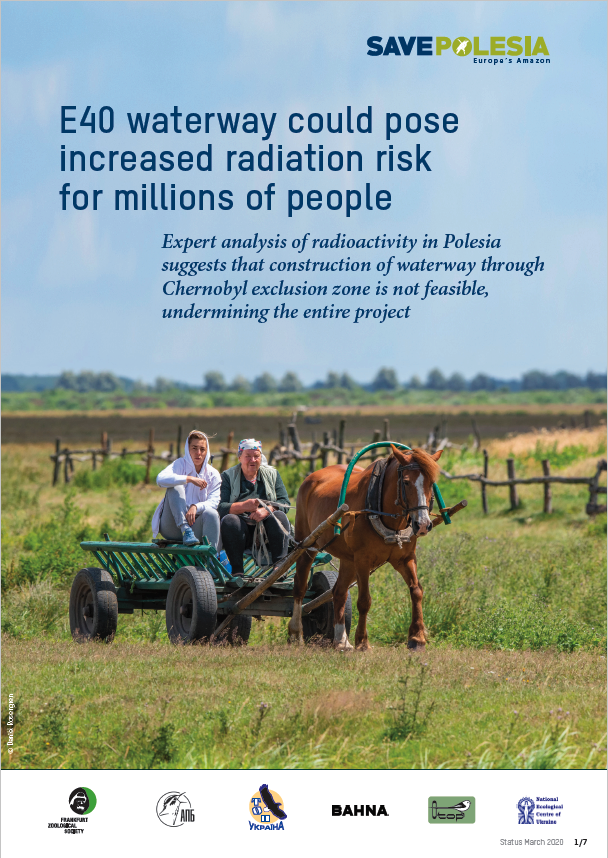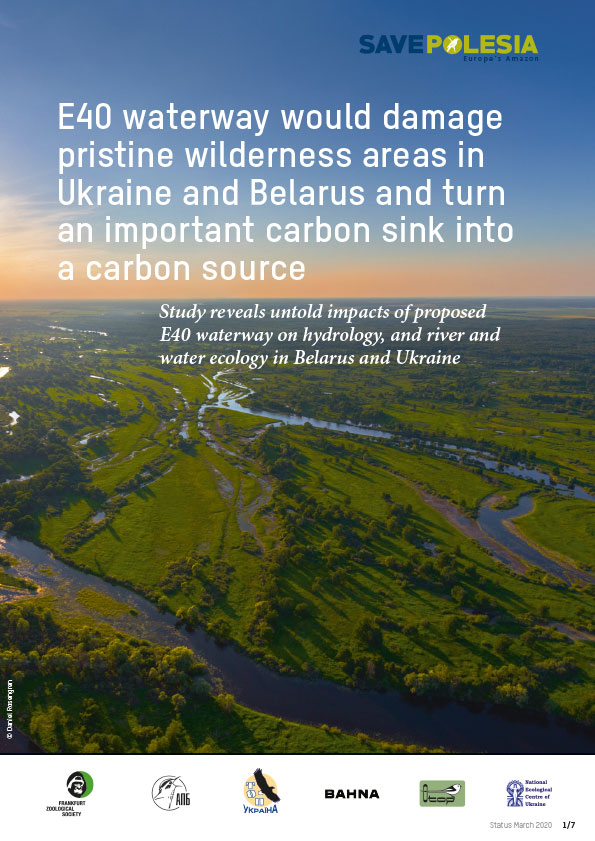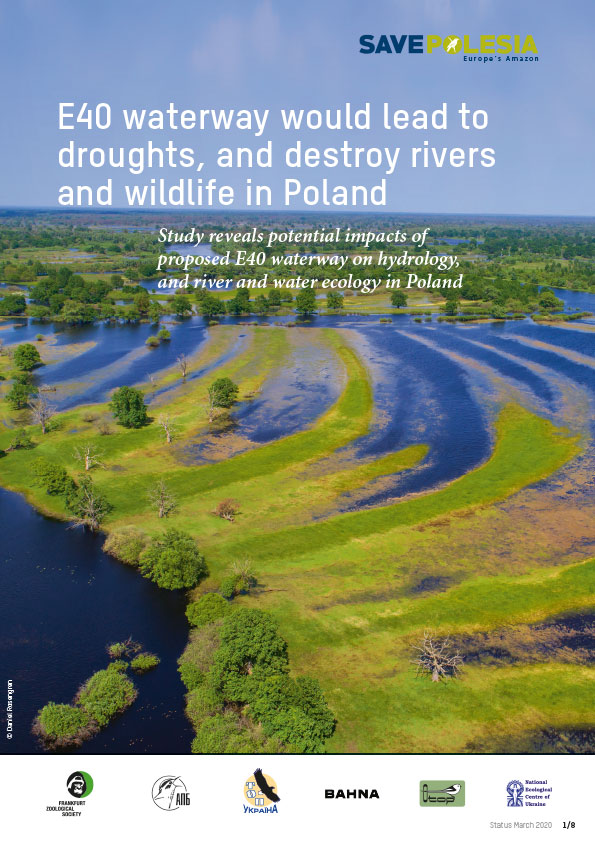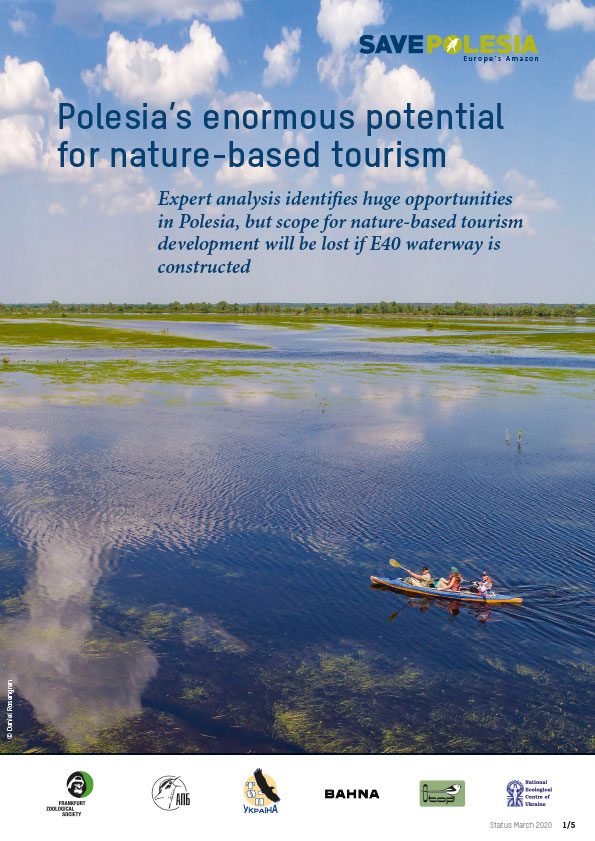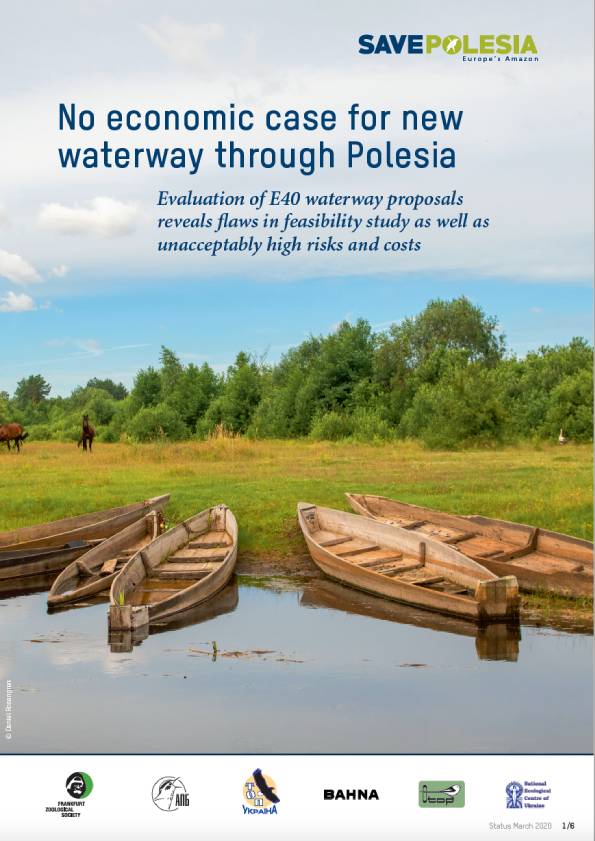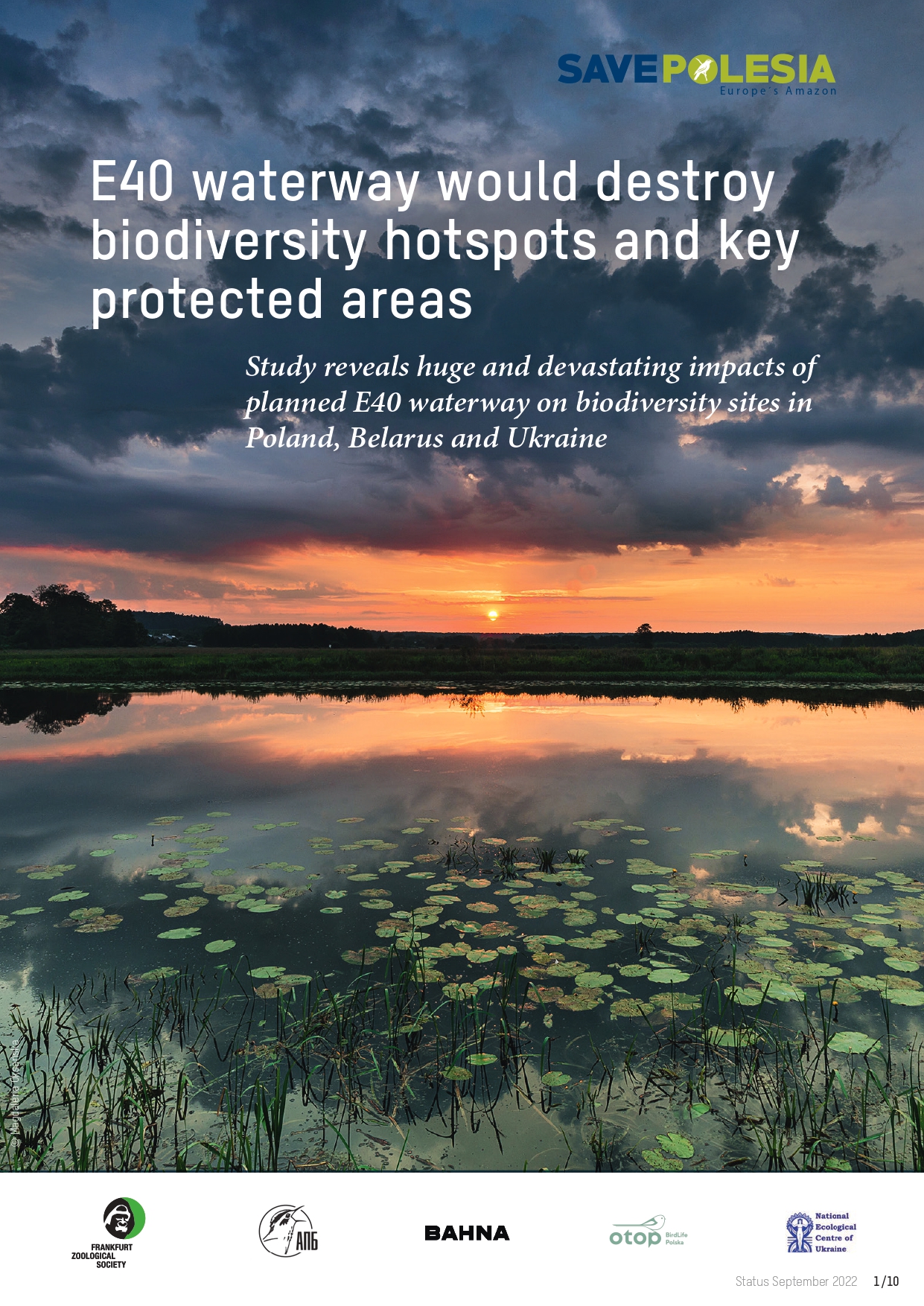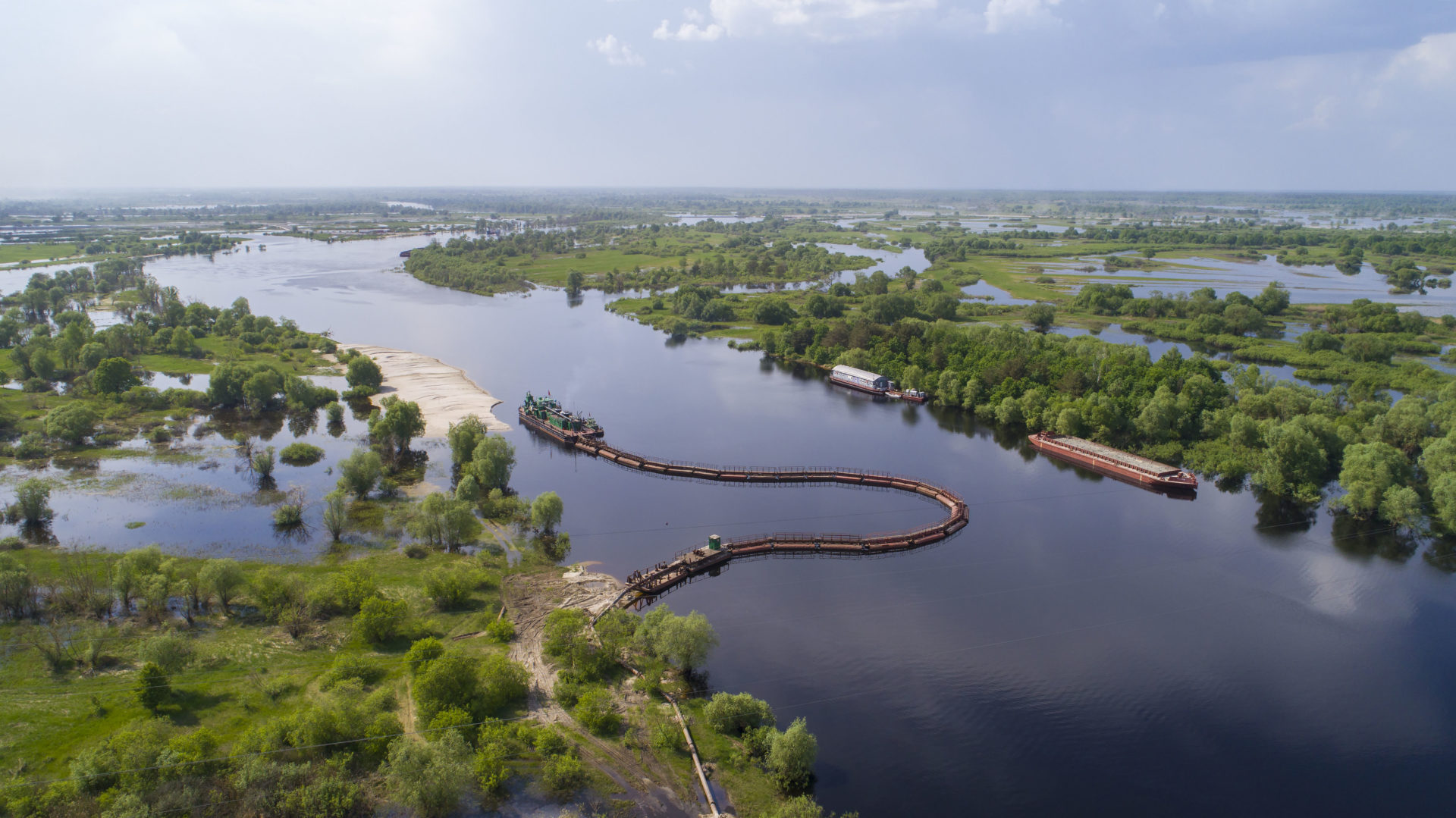
The Threat
Polesia under threat
In 2013, a partnership was set up to advance plans by the governments of Poland, Belarus and Ukraine to construct a shipping channel – the so called ‘E40 waterway’ – linking the Black Sea and the Baltic. They propose the creation of the longest waterway in Europe, stretching 2,000 km – more than 25 times the length of the Panama Canal. It would be designed for ships more than 80 meters in length. To accommodate them the channel must be at least 2.5 meters deep. And constructing it would destroy the heart of Polesia.
Data sources © pg-webstudio.de
Nature and communities at stake
To enable freight ships to navigate the waters would require straightening, deepening, damming, and dredging of rivers in some of the most environmentally sensitive parts of the region. The construction work could dry up rivers, directly impact 73 internationally protected areas (25 of which are in Polesia) and indirectly impact 120 more (59 in Polesia), threaten species, and potentially disturb radioactive pollution in the Chernobyl exclusion zone. Air pollution from ships would afflict major cities on the route, while accidents and oil spills are a major risk. The E40 waterway would undermine ecosystem services such as water retention, flood mitigation, clean air, and carbon storage. And it would destroy the fabric of local Polesian communities and their unique way of life.
Read the factsheet “E40 waterway would destroy biodiversity hotspots and key protected areas”.
Devastating impacts of E40 waterway
Experts have found that a 2015 feasibility study for the proposed E40 waterway has failed to account for crucial factors. These include the impacts of climate change; ice floes; invasive species; water quality and quantities; and hazardous radiation exposure. They also warn there would be severe negative impacts on local communities and the ecological status of key protected areas. They also point out that a lack of stakeholder and public consultation would likely contravene national and international law. Key findings are detailed below.
Millions of people exposed to increased radiation risk
The proposed E40 waterway would run through the Chernobyl exclusion zone. The risks presented by hazardous radiation from the 1986 nuclear disaster make the construction of the E40 waterway impossible. It will remain uninhabitable for decades. A 2006 report by the International Atomic Energy Agency (IAEA) found that the Dnieper and Pripyat rivers and floodplains were heavily polluted with radioactive material. Construction would risk disturbing several radiation hotspots in these areas. It could expose workers to dangerous levels of radiation and potentially contaminate the drinking water of millions of people.
Read the factsheet „E40 waterway could pose increased radiation risk for millions of people“.
Damaged pristine wilderness areas in Ukraine and Belarus and an important carbon sink turned into a carbon source
Construction of the E40 waterway would require dredging 6 million m³ of sediment from the Pripyat riverin the first year alone – enough to fill more than 2,000 Olympic swimming pools to the brim. 3.5 million m³ would be dredged across the E40 each subsequent year. This would cause major and unpredictable hydrological changes. Water would flow out of the area faster than it could be replenished, expansive wetlands would dry up. It would cut directly through 38 protected areas of international importance, including Pripyatsky National Park and the Almany mires – a huge complex of untouched mires and peatbogs. More than 2,000 km² of peatland could be affected in total. If drained this could result in annual emissions equal to those from 2 million cars. Habitats and stopover sites would be destroyed. Species such as the aquatic warbler would be at immediate risk of extinction.
Droughts, destroyed rivers and wildlife in Poland
Construction of the E40 waterway would involve a new channel in Poland, linking the Vistula river with the Poland-Belarus border. All proposed variations would lead to extreme consequences including droughts and the destruction of water resources used by citizens and farmers. A massive amount of water would be required, yet there are few viable water sources. Several key rivers would likely run dry or be severely altered. Water siphoned from rivers would require uphill pumping, which would be extremely expensive and may not be technically feasible.
Read the factsheet “E40 waterway would lead to droughts, and destroy rivers and wildlife in Poland”.
Losing Polesia´s enormous potential for nature-based tourism
There is huge potential for the development of sustainable nature-based tourism in Polesia. The region is home to pristine natural landscapes, immense wetlands, rare species, and unique floodplain forests, meadows, and mires. It is widely regarded as Europe´s Amazon. But like the Amazon, Polesia is under threat. The development of the E40 waterway would ruin nature-based tourism opportunities and cause an environmental catastrophe.
Read the factsheet “Polesia’s enormous potential for nature-based tourism”.
No economic case for new waterway through Polesia
An expert economic analysis of the proposed E40 waterway has laid bare huge capital expenditure, investment risks, and environmental consequences. Construction costs are expected to exceed €13 billion, a figure underestimated by a 2015 feasibility study. Any returns that are made will solely benefit businesses. Taxpayers would have to cover the costs of subsidies and would suffer unacceptable social, economic, and environmental impacts. The E40 waterway could also have detrimental impacts on local road and rail industries. It would take valuable resources away from more urgent investments. Proposals must be reconsidered, accounting for the critical ecosystem services that Polesia provides.
Read the factsheet “No economic case for new waterway through Polesia”.
Unacceptable impacts on biodiversity hotspots and key protected areas in Polesia and beyound
Experts found that the implementation of the E40 waterway would lead to huge and unacceptable impacts on protected areas, habitats and species. Impacts that will be significant at European level and which will be completely at odds with the international and European biodiversity commitments that the three countries have entered into, including commitments under the Convention on Biological Diversity and Ramsar and Bern Conventions. In Poland, the E40 project is at odds with commitments under the EU Biodiversity Strategy. The analysis makes it clear the E40 inland waterway project should be abandoned on biodiversity grounds alone. Until this happens it is not surprising that experts recognise E40 waterway as one of the top emerging issues of concern for global biodiversity conservation.
Read the factsheet “E40 waterway would destroy biodiversity hotspots and key protected areas”.

